Header logo
header top contact widget
Asheville Periodontist
A “Lecture-Free” Look At Cigarettes & Your Smile
Posted on Oct 11, 2023 by William J. Claiborne, DDS MS
In this article, I’m going to address cigarette smoking as it affects oral health. This is not intended to lecture or chastise an adult for making a choice to smoke or those caught up in the addictive grip of nicotine. My goal is to relay factual information regarding oral health for smokers so they can better protect their smiles.
Because I’m a native North Carolinian, I’ll begin by sharing some information on our State, as provided by 2018 stats from the CDC (Centers for Disease Control & Prevention).
In 2018, the percentage of adults in North Carolina who smoked was reported as 17.4% (of every 100 adults). The CDC shared findings of all states, with smoking ranged from nearly 9 of every 100 adults in Utah (9.0%) to 25 of every 100 adults in West Virginia (25.2%).
They also shared that cigarette smoking was lowest among those with a graduate degree (3.2%) and highest for those who had only achieved a GED certificate (30.7%). Those with a high school diploma showed a lower percentage of nearly half of the GED level adults at 17.1%.
As an Asheville periodontal dental specialist, smoking is a particular concern since many people are unaware of the oral health risks. While many smokers are familiar with the risks smoking poses related to cancer and other diseases, smoking is also terribly harmful to your smile.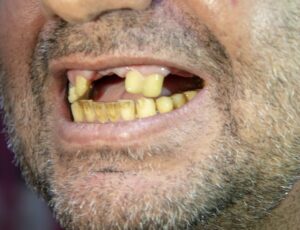
For instance, smokers have a greater risk of periodontal (gum) disease. The drying effect that smoking has on the soft tissues in the mouth offers an ideal breeding ground for oral bacteria. This enables easier entry of oral bacteria into the structures that support tooth roots.
According to the Centers for Disease Control & Prevention (CDC), a smoker has twice the risk for gum disease compared to that of a nonsmoker.
As oral bacteria thrive and reproduce in the mouth, gum tissues become tender and inflamed. These are signs of gingivitis, the beginning stage of gum disease.
Gum disease at this stage can cause persistent bad breath, swollen gums and gums that bleed easily when brushing. As it progresses, gum tissues turn red or purple from inflammation. Pus pockets may form at the base of some teeth. This advanced stage is known as periodontitis.
Eventually, the infectious bacteria penetrate below the gum line and attack supporting bone and the tissues surrounding tooth roots. This can cause teeth to loosen and eventually require removal. Gum disease is the nation’s leading cause of adult tooth loss.
Losing teeth is detrimental to your overall health and not a normal part of the aging process. Studies have shown that people who wear dentures die an average of ten years earlier than those who keep their natural teeth.
Denture wearers also have higher incidences of pneumonia, and worse. A 2015 report by NBC News shared findings surrounding dentures and MRSA biofilm. The report included a dental specialist’s warning that, “Concern about biofilms on dentures is growing as researchers continue to identify links between oral bacteria and heart disease, chronic obstructive pulmonary disease or COPD, and respiratory diseases, including aspiration pneumonia.”
Many smokers are aware that they have stained teeth and more-frequent bad breath than non-smokers. They also have slower healing periods after procedures such as extractions, gum treatment and oral surgery.
Although a hygienist may go slowly and gently, dental cleanings are typically less comfortable for smokers. This is because smoking causes a greater buildup of plaque. With gum tissues already tender from the bacterial irritation of plaque, removing buildup from between and around the base of teeth adds to the discomfort of inflamed tissues.
According to the American Dental Association (ADA), smoking increases the risks of oral cancer, lesions inside the mouth, enamel erosion and tooth loss in addition to periodontal (gum) disease.
If you vape, remember that nicotine in any form is a hazardous force in the mouth. And the vapor itself is not safe for oral health.
Vaping (using e-cigarettes) delivers nicotine through an inhaled mist. Although the vapor is generally not labeled as “dangerous,” one study of some e-cigarette products found the vapor contains known carcinogens and toxic chemicals, including, propylene or polyethylene glycol, glycerin, and additives. And, its nicotine is no less harmful to the user as that delivered via cigarette smoke.
Unfortunately, many cigarette users switch to vaping based on the perception that “e-cigs” are a safer alternative. For those hoping to wean themselves off cigarettes through this switch, very few achieve that goal as a result.
A 2018 report by the National Academy of Sciences, Engineering, and Medicine concluded there was “evidence that e-cigarette use increases the frequency and intensity of cigarette smoking in the future.”
Although the focus in this article is meant to be on oral health, allow me to reiterate some of the benefits of “kicking the habit” …
• Smokers have a decreased life expectancy of an average of 10–15 years compared to non-smokers.
• Smoking is linked to nearly a third of all cancer diseases and deaths.
• Pregnant women who smoke have a higher risk for first-trimester spontaneous abortion, preterm births, low birth weight babies and sudden infant death syndrome (SIDS).
• Women who smoke are at risk for early menopause while men who smoke are more at risk for impotency.
• People who breathe in your “second hand” smoke (what you exhale) are subjected to over 50 known carcinogens and other harmful chemicals.
For those who are able to give up smoking, the effort is well worth it. The positive effects can be felt almost immediately. In about 48 hours, damaged nerve endings begin to restore. The sense of smell and taste begin to return to normal.
“Quitters” also notice their breathing is easier in about 3 days and they have fuller air intake. Oral health improves within 2 weeks as blood circulation in the gums and teeth returns to nearly that of non-smokers. Heart attack risk also declines with blood flow greatly improving. Activities are easier and the constant smokers cough is gone.
 In our Asheville periodontal office, our goal – for every patient – is to help each achieve optimal oral health and a smile he or she is proud to share. For those who smoke, we make individualized recommendations so the potential for achieving this is favorable.
In our Asheville periodontal office, our goal – for every patient – is to help each achieve optimal oral health and a smile he or she is proud to share. For those who smoke, we make individualized recommendations so the potential for achieving this is favorable.
If tooth loss has already occurred, we are specialists in the treatment of all stages of gum disease and in the diagnosis and placement of dental implants. We will be happy to discuss the dental implant system that may be best for your needs.
Or, if dental fear or anxiety have kept you from receiving regular dental care, ask us about oral or IV sedation (“twilight sleep”). These sedatives are delivered by an MD of anesthesia for your optimal safety and comfort. And, in all procedures, we make patient comfort a high priority.
Call 828-274-9440 to schedule an examination.
Sources:
https://www.cdc.gov/tobacco/campaign/tips/diseases/periodontal-gum-disease.html
https://www.sciencedaily.com/releases/2016/11/161116101821.htm
https://www.nbcnews.com/healthmain/dirty-dentures-dangerous-mrsa-may-be-lurking-dentists-say-662637
https://www.cdc.gov/tobacco/basic_information/e-cigarettes/index.htm
Let’s Talk About Your Breath.
Posted on Sep 28, 2023 by William J. Claiborne, DDS MS
Who, me?
While many people may suspect their breath is less-than-fresh, most don’t realize that others are noticing. And, let’s face it – no one wants to be associated with bad breath.
Bad breath that is persistent, or halitosis, is not just the stale odor in your mouth when you wake up or the lingering scent of onions on a burger you had for lunch. Halitosis is typically a symptom that results from other conditions. While chewing gum and breath mints may temporarily improve the odor, going bad breath will continue until the root cause has been determined and treated.
I’ve often heard, “If you think you might have bad breath, you probably do.” To check your own breath, Colgate suggests: “Try the sniff test—there are a couple of ways to do it. If you lick your wrist, let it dry for a moment, then take a whiff, you should be able to get an idea if your breath has an odor too. Another method is to floss toward the back of your mouth, then smell the floss.”
If you feel bad breath is a constant problem, then halitosis is likely what needs to be the focus. And, where is it originating? Gum disease? GERD? Diabetes?
It may make you feel better to know that halitosis is actually fairly common. It is estimated to affect 1 in 4 people worldwide. It may be so common because the reasons it exists can vary widely. These can include:
• Poor oral hygiene – Without a thorough at-home oral hygiene routine, oral bacteria accumulate. At minimum, twice-daily brushing, flossing and 6-month dental cleanings are needed to keep harmful bacteria under control. If not, plaque forms, which is the sticky film that layers over teeth and gums. Plaque can harden into masses of bacteria known as tartar. Tartar can no longer be removed by brushing and flossing.
• Gum disease – The early stage of gum disease is gingivitis. This is an inflammation of gum tissues that cause gums to swell, become tender and bleed easily when brushing. Untreated gingivitis can lead to periodontitis, which damages gum tissue and can lead to tooth and bone loss of the structures that support natural teeth.
• Dry mouth – Saliva is the mouth’s natural rinsing agent, removing food particles and bacteria from the mouth. Without adequate saliva flow, it can lead to halitosis. Smoking, certain medications, and some foods and beverages contribute to oral dryness.
• Gastroesophageal reflux disease (GERD) – This digestive disorder allows stomach acids to seep back into the esophagus, the tube that takes food from your mouth to your stomach.
• Nasal and airway infections – When congestive mucus from conditions like sinus infections and pneumonia are coughed up, a foul odor can emerge from the mouth.
• Diabetes – People with diabetes have a higher risk of gum disease. By the same token, gum disease can make it harder to manage diabetes because of increased blood sugar.
• Liver disease or kidney disease – The liver and kidneys are designed to filter toxins out of your body. When people have liver or kidney disease, these toxic substances aren’t being cleared out, resulting in halitosis.
• Sjögren’s syndrome – This autoimmune disease can lead to muscle pain, dry eyes, dry skin and dry mouth (which is often linked to halitosis).
• Head and neck cancers – Oral or throat cancers cause sores that don’t heal, mouth pain, difficulty swallowing, a lump in your neck and unexplained weight loss.
If you have bad breath that doesn’t go away, schedule an appointment with your dentist. If halitosis is due to poor oral hygiene, a dental cleaning or periodontal (gum) procedure should help. If you have healthy teeth and gums, then halitosis may be linked to an issue in another part of your body.
If halitosis is a symptom of another condition somewhere in your body, your primary healthcare provider can help you with proper diagnosis and treatment. Once your physician determines the cause of your halitosis, he or she can develop a treatment plan tailored to your specific needs.
However, if gum disease is the cause, a periodontist can help resolve your problem in the most conversative yet effective process possible. If gum disease is the cause for your halitosis, a procedure known as scaling and root planing may be advised. This helps to reach inflammatory bacteria that have moved down below the gum line.
Once your gums are restored to a healthy state, your periodontist may advise added at-home steps, such as a special mouthwash to combat certain bacteria in your mouth. However, proper oral hygiene is the best way to keep your breath smelling clean and fresh. Here are some general guidelines:
• Use an alcohol-free antibacterial mouthwash.
• See your dentist regularly for checkups and cleanings. For some people, this may be every six months. But others may need more frequent visits to keep their oral health in check.
• Keeping a moist mouth is very important to oral hygiene. Drinking plenty of water during the day is advised. Colas, sweet tea, and energy drinks actually make dryness worse. You should also monitor the medications you take (both prescription and over-the-counter) and look for side effects that include oral dryness. And, smoking is one of the worst contributors of all to oral dryness.
• Proper brushing and flossing is necessary. Brush for at least two minutes twice daily and rinse thoroughly. Use a circular motion rather than scrub teeth back and forth to avoid damaging tender gum tissues. Never use a hard bristle tooth brush or brush with harsh substances such as baking soda!
• The tongue harbors a significantly high percentage of oral bacteria. After brushing, use a tongue scraper to uproot oral bacteria embedded in the grooves of the tongue. This will significantly lower bacteria levels. A study at the State University of New York at Buffalo School of Dental Medicine found that 80 to 90% of bad breath comes from bacteria on the tongue.
• Boost the production of saliva by using sugar-free chewing gum, sucking on sugar-free candy or eating healthy foods that require a lot of chewing. Your dentist might recommend or prescribe products that can produce artificial saliva or help your body produce saliva.
• Avoid alcohol, caffeine and tobacco products because they can dry out your mouth.
It is also important to know the signs of gum disease (bleeding or sore gums, persistent bad breath, receded gums, and/or gums that are red rather than a healthy pink). If these are present, it is important to see a periodontal specialist as soon as possible. Gum disease will only worsen without treatment. It can also allow infectious bacteria to enter the bloodstream, which research has linked to serious (and even deadly) health problems.
Call our Asheville periodontal dental office to schedule an examination or begin with a consultation. If fear or anxiety has prevented you from regular dental visits, we can discuss several options (including oral or IV sedation) to provide comfortable, relaxed appointments. Call 828-274-9440.
Sources:
http://www.dentistryiq.com/articles/2014/04/a-deeper-look-into-tongue-cleaning.html
https://my.clevelandclinic.org/health/diseases/17771-bad-breath-halitosis
https://www.colgate.com/en-us/oral-health/bad-breath/how-to-tell-if-you-have-bad-breath#
Oral Health & Tooth Loss Within America’s Aging Population
Posted on Sep 18, 2023 by William J. Claiborne, DDS MS
There are currently 54.1 million U.S. adults ages 65 and over; a number that is expected to grow to 95 million by 2060.
In 1900, the percentage of American adults over the age of 65 was just 4.1%. Today, that number has grown to nearly 16%. By 2040, the elderly adult population is estimated to be more than double the senior population of the year 2000.
https://www.aplaceformom.com/caregiver-resources/articles/elderly-nursing-home-population
Many baby boomers (Americans born between 1946 – 1964) will keep their teeth longer than any generation before, yet they continue to experience a preventable decline in oral health.
Common risk factors such as smoking, poor diet, a reduced capacity to care for one’s teeth and obtain professional dental care, and biological mechanisms – such as low salivary flow caused by medications – may contribute to tooth decay and tooth loss.
Periodontitis (advanced gum disease) is a prevalent oral disease in older adults. It is typically marked by inflammation of the gums and supporting structures of the teeth, resulting in sore and bleeding gums as well as painful chewing problems. Loss of the supporting structures of the teeth (including supportive bone) results from an imbalance of bacteria that exist in the space between the teeth and the gums. This leads to an inflammatory response that develops into periodontal disease.
As teeth lose support from their diseased foundation, mobility and tooth drifting can occur in addition to abscesses, which can ultimately result in tooth loss. As the disease intensifies, bone loss around affected teeth can advance with a worsening infection that can lead to serious health problems far beyond the mouth.
Periodontal disease is associated with chronic diseases such as cardiovascular disease, diabetes, respiratory disease, and dementia. Along with other challenges to maintaining good health, the prevalence of any periodontitis among older adults is high. Three in five older adults are affected, with prevalence higher in men and persons with low incomes. Four in five older adults who smoke cigarettes have some form of periodontitis.
The loss of all natural teeth, known as edentulism, reduces quality of life because it interferes with the ability to eat, speak, and feel comfortable among other people. Tooth loss also affects a person’s ability to consume nutritious food and can impact social involvement with others while consuming food.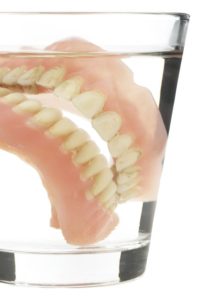
Overall, 17% of adults 65 and older are edentulous. Fortunately, edentulism has declined over the years among older adults aged 65 to 74, from about 50% in the 1960s to 13% today.
https://www.cdc.gov/oralhealth/pdfs_and_other_files/Oral-Health-Surveillance-Report-2019-h.pdf
Prevalence of total tooth loss among adults ages 65 and over is higher in both North and South Carolina than many other states, which is in the 16.6 – 26.3 percentage range. This compares to states like Illinois, Wisconsin and Utah, which are some states in the 6.2 – 11.3 percent range.
https://www.ncbi.nlm.nih.gov/books/NBK578296/figure/ch6.fig6/?report=objectonly
Having fewer than nine teeth is considered severe tooth loss and can cause major difficulties in eating a healthy diet of fresh and nutritious fruits, protein-rich meats and sufficient fiber. Without chewing comfort, strength and stability, food choices can result in either weight loss or obesity. Extensive tooth loss also detracts from physical appearance and impedes speech, another challenge to social contact and job prospects. This can also inhibit intimacy, lower self-esteem, and impact overall quality of life.
https://www.nidcr.nih.gov/sites/default/files/2017-10/hck1ocv.%40www.surgeon.fullrpt.pdf
Another challenge for older adults is orofacial pain. Orofacial pain in older adults can originate inside the mouth from tooth-related or gum infections. It may also originate outside the mouth, such as pain in the jaw joint area, or face and cheeks. Orofacial pain often results from ill-fitting dentures or a microbial infection causing an inflammatory reaction known as denture stomatitis (an oral yeast or fungus condition)
Older adults also struggle with “dry mouth.” Dry mouth is surprisingly common – an estimated 35 million U.S. adults may have this condition, known as xerostomia. Common causes include medications, autoimmune disease, systemic diseases, and as a result of head and neck irradiation.
Drugs are by far the most common risk factors for chronic dry mouth. Nearly 9 in 10 (89%) adults aged 65 and older take prescription medicine. More than half (54%) report taking four or more prescription drugs. The drugs most consistently implicated in “dry mouth” are antidepressants, diuretics, beta blockers, bronchodilators, and antihistamines.
High-risk behaviors are generally less common among older adults than in younger age groups. About 9% of those 65 years and older reported that they were current smokers, and 8% reported excessive alcohol consumption (having five or more drinks in one day at least once in the past year). Cannabis use also is on the rise among seniors although it remains less than 5%.
The problems associated with poor oral health and tooth loss extend greatly to other areas of the body. Oral bacteria and their toxins can spread into the bloodstream through ulcerated or inflamed tissues during chewing, routine oral hygiene, and dental procedures. In weakened gum tissues, even the act of tooth brushing can open up entry points for bacteria plaque and gingival inflammation in the bloodstream.
In addition, the presence of oral bacteria or their toxins may induce inflammatory responses, which can prompt insulin resistance. Oral bacteria can reach tissues in the lung, heart, gut, placenta, joints, and even the brain. They have been associated with infective endocarditis, and chronic inflammation may contribute to systemic conditions such as cardiovascular disease and diabetes.
Obviously, there are many causes for oral health challenges, all having a detrimental effect on quality of life to some extent. We want to help the residents of Western North Carolina enjoy their retirement years with a healthy, confident smile and oral health that supports good overall health.
First, know the signs and symptoms of periodontal (gum) disease, which include:
• Swollen or puffy gums
• Gums that turn red, dark red or dark purple gums
• Gums that are tender or bleed easily
• Seeing blood when brushing or flossing
• Persistent bad breath
• Pus pockets that form between teeth and gums
When periodontal disease exists, it is important to know that this will not go away without treatment. Once this infection is underway, it will only worsen, leading to more painful symptoms and even eventual tooth loss.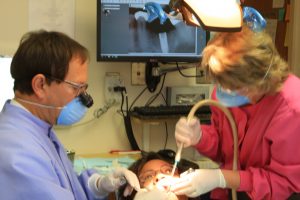
If you have signs of gum disease, see a periodontal specialist as soon as possible. In addition to lowering the risk of tooth loss, a periodontist can help you lower the risks of gum disease’s infectious bacteria in the bloodstream, which research has linked to serious (and even deadly) health problems.
Call our Asheville periodontal dental office to schedule a consultation. If fear or anxiety has prevented you from regular dental visits, we can discuss several options (including oral or IV sedation) to provide comfortable, relaxed appointments. Call 828-274-9440.
Common Contributors to Tooth Loss
Posted on Sep 11, 2023 by William J. Claiborne, DDS MS
Our natural teeth seem hard and solid, able to endure much over the span of a lifetime. However, as we all know, teeth can be knocked out due to accidents or injury and lost due to becoming overly decayed, fractured, infected and – the leading cause – periodontal (gum) disease.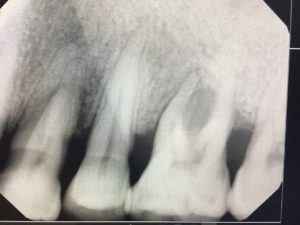
Your gum tissues serve as protection for the tooth structures you cannot see – the tooth roots and bone and tissues supporting the roots. And, teeth need these bone structures to stay healthy and vice versa; the bone structures beneath the gums need the presence of the roots to stay healthy.
The jaw bones are kept healthy by tooth roots that provide stimulation to the bone as well as nourishment that runs through the tooth’s interior.
When a tooth is removed, so is the stimulation and nourishment to that area of the jaw bone. Without it, the bone begins to shrink. As it declines in height, adjacent teeth are more vulnerable to loss. Statistics show that teeth adjacent to areas where natural teeth are missing will be the most likely to be lost next.
According to the Center for Disease Control & Prevention (CDC), 69% of adults between ages 35 – 44 have lost at least one permanent tooth. By age 50, Americans are missing an average of 12 teeth. For adults between the ages of 65 – 74, 26% are missing all of their natural teeth. That’s over one-fourth of the adult population over age 65.
Because of the strength and seemingly rock-solid presence of teeth, it may be assumed they’ll last for a lifetime. And, they can. Natural teeth can and should last a lifetime with proper maintenance and care. However, certain things can contribute to tooth loss; some of these may not be well known.
These include:
GUM DISEASE – Signs and symptoms of gum disease are:
• Red, swollen or tender gums
• Seeing blood in the sink when brushing
• Receded gums
• Loose or separating teeth
• Pus pockets on gum tissues
• Sores in the mouth
• Persistent bad breath
When these indications exist, it is important to seek periodontal treatment as soon as possible. Gum disease only worsens without treatment, requiring more time and expense to rid this serious, even deadly, inflammatory disease.
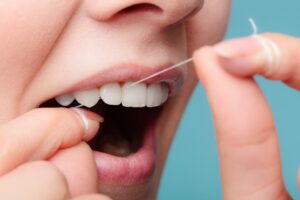 NOT FLOSSING – While tooth brushing helps to keep oral bacteria levels in the mouth to manageable levels, daily flossing is also recommended as a preventative way to keep cavities and gum disease at bay. Still, 70% of the American adult population do not floss daily. Even worse, about a third of Americans admit to never flossing (39% of men and 27% of women who do not).
NOT FLOSSING – While tooth brushing helps to keep oral bacteria levels in the mouth to manageable levels, daily flossing is also recommended as a preventative way to keep cavities and gum disease at bay. Still, 70% of the American adult population do not floss daily. Even worse, about a third of Americans admit to never flossing (39% of men and 27% of women who do not).
SMOKING – According to the Centers for Disease Control & Prevention (CDC), a smoker has twice the risk for gum disease compared with that of a nonsmoker. (https://www.cdc.gov/tobacco/campaign/tips/diseases/periodontal-gum-disease.html)
AGING – With age, the body becomes less efficient in maintaining itself. Due to hormone changes and being less hydrated, joints wear down, skin loses subtlety and muscle mass and strength declines. The same is true with teeth, especially as gum tissues dry out. This means their tight, protective grip around the base of teeth loosens and pockets can easily for between teeth. All these factors contributor to higher risks of gum disease and tooth loss.
ORAL DRYNESS – The tissues inside the mouth need to be kept moist. Saliva flow is designed to do this. However, with age, the flow of saliva is less plentiful. Just as the skin and hair get drier with age, the mouth endures this same consequence. When saliva flow is less efficient at rinsing bacteria from the oral cavity (inside of the mouth), bacteria grow at a more rapid rate. This means bacteria accumulation occurs more frequently than twice-a-day brushing can control.
MEDICATIONS – The average adult in the 65-79 age group has over 27 prescriptions filled each year. (https://www.statista.com/statistics/315476/prescriptions-in-us-per-capita-by-age-group/). Many meds have the side effect of oral dryness or increased bleeding, including some herbal supplements. For example, Ginkgo Biloba and Vitamin E can act as blood thinners. When combined with aspirin, the combination may cause difficulties in blood clotting.
To halt the potential for tooth loss if you are already missing teeth, dental implants are recommended. They actually protect the health of neighboring teeth. In addition to helping the supportive bone structures retain bone mass, teeth supported by implants do not rely on the support of crowned (or ‘capped’) teeth on both sides. This means the integrity of adjacent teeth is preserved.
Dental implants come in over 40 different types designed to accommodate various challenges and preferences. This is one reason (of many) that a periodontist is an ideal choice for the diagnosis and placement of your implants. Our speciality understands the complete spectrum of implant systems. While some implant systems may be ideal for your needs, others may not. And, the choice of which will achieve your goals is not limited to just those types a non-specialist knows how to place.
For example, some dental implants provide you with a non-removable (“fixed”) option while others may involve removable teeth. Additionally, the proper selection of your dental implants may greatly save you in treatment fees.
For example, the All-On-4 dental implant system needs only 4 implants per arch, and can be placed in shallow bone. The treatment fees are less since the number of implants is low and the need for bone regeneration for severe bone loss may not be required. For these reasons, a periodontist may be able to help you achieve your tooth replacement goals within a budget you can manage.
Our Western NC periodontal dental office features some of the industry’s most advanced technology, which helps to optimize success rates, shorten treatment time, and enhance comfort. This includes 3-D Cone Beam imaging, which is ideal for diagnoses and treatment planning. These amazing images provide a clear view of the upper and lower jaw (including nerve canals) in a process that is quick, painless and at minimal radiation levels.
We also have a computerized Dental Implant Placement system for pre-surgical positioning of dental implants. Using a 3D model of the patient’s jaw, a template is developed for the most conservative treatment process needed, even for complex cases. This minimizes disruption of gum tissues and targets implant placement at ideal depths and angles.
Because we make patient comfort one of our highest priorities, we offer several sedation options, including oral and IV sedation. Oral sedation is a pill that helps patients relax. It also has an amnesiac effect, leaving most with little or no memory of treatment afterward. I.V. sedation (also known as “twilight sleep”) places the patient in a deeper sleep state and erases memory of the procedure. It is administered by a Medical Doctor (MD) who is a board certified Anesthesiologist.
If you have lost teeth (or struggle with a denture or partial) and are considering dental implants, begin with a consultation appointment. Call 828-274-9440. New patients are always welcome.
Recent Posts
Categories
Archives
- September 2024
- August 2024
- July 2024
- June 2024
- May 2024
- April 2024
- March 2024
- February 2024
- January 2024
- December 2023
- November 2023
- October 2023
- September 2023
- August 2023
- July 2023
- June 2023
- May 2023
- April 2023
- March 2023
- February 2023
- January 2023
- December 2022
- November 2022
- October 2022
- September 2022
- August 2022
- July 2022
- June 2022
- May 2022
- April 2022
- March 2022
- February 2022
- January 2022
- December 2021
- November 2021
- October 2021
- September 2021
- August 2021
- July 2021
- June 2021
- May 2021
- April 2021
- March 2021
- February 2021
- January 2021
- December 2020
- November 2020
- October 2020
- September 2020
- August 2020
- July 2020
- June 2020
- May 2020
- April 2020
- March 2020
- February 2020
- January 2020
- December 2019
- November 2019
- October 2019
- September 2019
- August 2019
- July 2019
- June 2019
- May 2019
- April 2019
- March 2019
- February 2019
- January 2019
- December 2018
- November 2018
- October 2018
- September 2018
- August 2018
- July 2018
- June 2018
- May 2018
- April 2018
- March 2018
- February 2018
- January 2018
- December 2017
- November 2017
- October 2017
- September 2017
- August 2017
- July 2017
- June 2017
- May 2017
- April 2017
- March 2017
- February 2017
- January 2017
- December 2016
- November 2016
- October 2016
- September 2016
- August 2016
- July 2016
- June 2016
- May 2016
- April 2016
- March 2016
- February 2016
- January 2016
- December 2015
- November 2015
- October 2015
- September 2015
- August 2015
- July 2015
- June 2015
- May 2015
- April 2015
- March 2015
- February 2015
- January 2015
- December 2014
- November 2014
- October 2014
- September 2014
- August 2014
- July 2014
- June 2014
- May 2014
- April 2014
- March 2014
- February 2014
- January 2014
- December 2013
- November 2013
- October 2013
- September 2013
- August 2013
- July 2013
- June 2013
- May 2013
- April 2013
- March 2013
- February 2013
- January 2013
- December 2012
- November 2012
- October 2012
- September 2012
- August 2012
- July 2012
- June 2012


